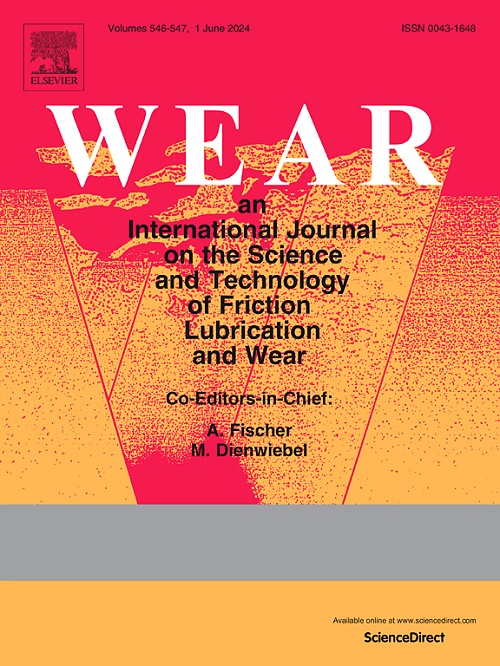Effect of pulsed current coupled ultrasonic rolling on surface fretting friction and wear properties of Ti-6Al-4V alloy
IF 5.3
1区 工程技术
Q1 ENGINEERING, MECHANICAL
引用次数: 0
Abstract
Surface friction properties of Ti-6Al-4V alloy after pulsed current coupled ultrasonic rolling (PCUR) treatment were studied in this paper. The research results showed that the process of PCUR treatment effectively improved the microstructure of material surface layer relative to the only ultrasonic rolling (UR) treatment. The maximum thickness of the deformation layer was about 40μm and accompanied by the fine grain and dense dislocation. Moreover, there were no significant micro defects in material surface layer after PUSR treatment. It was attributed to the effective material plastic deformation and grain refinement effects promoted by pulsed current assisted high-frequency ultrasonic vibration. Meanwhile, it significantly reduced surface roughness of the material to a minimum of 0.18μm. The specimen showed the large hardening depth (300 μm) and high surface microhardness (530 HV) after PCUR processing. Meanwhile, the influence depth of residual stress was extended to 0.53 mm. Surface friction properties of the specimens after PCUR and UR treatment were tested with GCr 15 and Si3N4, and the specific wear mechanism was analyzed. It was found that the specimen after PCUR treatment had the lower coefficient of friction (CoF) and smaller wear scar compared with the sample treated by UR treatment and showed a lower wear rate. The main reason was that pulsed current coupled ultrasonic rolling effectively promoted material surface layer to produce good plastic deformation, reduce the microscopic defects and refine the grain size.
求助全文
约1分钟内获得全文
求助全文
来源期刊

Wear
工程技术-材料科学:综合
CiteScore
8.80
自引率
8.00%
发文量
280
审稿时长
47 days
期刊介绍:
Wear journal is dedicated to the advancement of basic and applied knowledge concerning the nature of wear of materials. Broadly, topics of interest range from development of fundamental understanding of the mechanisms of wear to innovative solutions to practical engineering problems. Authors of experimental studies are expected to comment on the repeatability of the data, and whenever possible, conduct multiple measurements under similar testing conditions. Further, Wear embraces the highest standards of professional ethics, and the detection of matching content, either in written or graphical form, from other publications by the current authors or by others, may result in rejection.
 求助内容:
求助内容: 应助结果提醒方式:
应助结果提醒方式:


